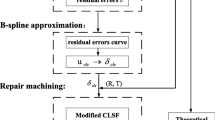Abstract
The current repair process for worn-out turbine blades and blisks is very manual, and experience based and hence is error-prone. It requires sophisticated CNC-driven (Computer Numerical Control) laser equipment to replace manual welding for the repair. This paper presents an innovative strategy that can lead to the automation of laser welding and cladding. The project makes use of reverse engineering techniques to capture the geometric shape of the worn area by digitized point cloud and nominal geometry. The core software technologies include four aspects: (i) point-to-surface-best-fitting technology that puts the point cloud coordinate system nominal CAD (Computer Aided Design) coordinate system, (ii) a procedure to extract a worn boundary that automatically separates the worn area and the undamaged area, (iii) geometric model representation for the worn area, and (iv) generation of an STL file to drive the CNC laser machine. The tool has been implemented using UG API (Unigraphics Application Programming Interface). Some experimental results have shown that the presented strategy is efficient for repair automation.
Similar content being viewed by others
References
Productive reverse engineering and adaptive machining. http://www.bct-online.de/index_e.html. Cited 25 May 2002
Toolroom technology design and manufacturing. http://www.ttl-3d.co.uk/dmmain.htm. Cited 25 May 2002
Adaptive manufacturing technology, http://www.amtautomation.com/. Cited 25 May 2002
Adaptive solutions for digital manufacturing. http://www.inteplan.com/inteplan.htm. Cited 25 May 2002
Adaptive manufacturing & operations, http://www.us.cgey.com/ind_serv/services/supply_chain/ /approach_adaptmfg.asp. Cited 25 May 2002
Lee KH, Woo H (2000) Direct integration of reverse engineering and rapid prototyping. Comput Ind Eng 38(1):21–38
Lin YJ, Lee TS (1999) An adaptive tool path generation algorithm for precision surface machining. Comput Aided Des 31(4):237–247
Foley JD, van Dam A, Feiner SK, Hughes JF (1996) Computer graphics principles and practices. Addison-Wesley, Boston
Author information
Authors and Affiliations
Corresponding author
Rights and permissions
About this article
Cite this article
Zheng, J., Li, Z. & Chen, X. Worn area modeling for automating the repair of turbine blades. Int J Adv Manuf Technol 29, 1062–1067 (2006). https://doi.org/10.1007/s00170-003-1990-6
Received:
Accepted:
Published:
Issue Date:
DOI: https://doi.org/10.1007/s00170-003-1990-6




